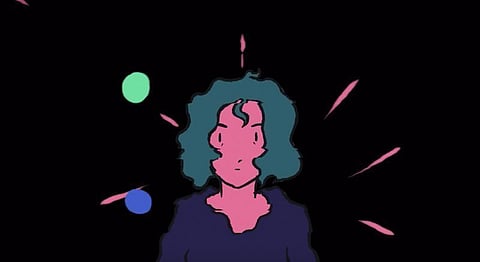
- HOMEGROWN WORLD
- #HGCREATORS
- #HGEXPLORE
- #HGVOICES
- #HGSHOP
- CAREERS
- ABOUT US
- CONTACT US

“I could keep falling, I could keep falling in, I could keep falling in love.” And we do, reinventing and analysing the concept with every text message, swipe right or late-night phone call. In this post internet, borderline fictionalised age where reality seems to be catching up with supposed fiction, our phones are the gateways to our hearts–and we’re always plugged in. Delhi-based independent electronica artist Tarana Marwah (who performs as Komorebi) lays bare our increasing dependence on these new avenues for love in the 21st century, and takes a closer look at the pleasure (and pain) of unrequited love with her newest video ‘Candyland’ from her debut album Soliloquy. The four minute-long video is made up of 240 heartbeats, where viewers will find themselves reaching into the murky depths of those unfinished, half-begun romances that never really take off at all. The agony of missed calls, texts left unanswered, and a never-ending battle in the head that plays out in excruciating detail–Tarana describes Candyland as an “oddity in the album” one that will find itself being played on loop because of its powerful, universal appeal.
The accidental soundtrack to my latest heartbreak, I find myself falling down the magical rabbit hole that Tarana and animator Sharath Ravishankar have created. With animation as its chosen medium (unsurprising if you’ve kept track of the artist’s trajectory) the duo have woven together a compelling narrative of modern love, and I cannot look away. Perhaps it is because it brings together all the elements that Tarana is so passionate about, to tell a story that is a fitting tribute to her musical identity. “Since my project was inspired by original soundtracks from anime I watched when I was younger, I wanted to use animation as an artistic medium which I will continue to do for all the videos,” she says. Her stage name, Komorebi, is a Japanese word for the interplay between light and leaves when sunlight shines through trees, an ode to the culture she is so heavily influenced by. “When I was a pre-teen and easily influenced, anime really changed my life. It’s still a huge part of who I am and a lot of the soundtracks I listened to made me want to be a composer, which is still my goal,” she explains when I ask her how anime came into her life. The video is particularly special because of its treatment–a story set to the soundtrack of Tarana’s lovely, haunting voice, brought to life by Sharath’s powerful imagination. “He’s a very talented student that I happened to find on Instagram. I reached out to him promptly (much like I do with most) and told him I loved his art style while simultaneously flirting with the idea of working together on a video,” Tarana tells me. A creative partnership that was almost destined, Sharath believes. “The story was one that I had sitting in the back of my head for a while, though I hadn’t a chance to execute it until Tarana approached me with her album that I had a surprisingly appropriate context to work within.”
The simple, stripped-down visual style of the video lets you dwell on the narrative without too many distractions, unlike your phone that’s probably buzzing with new notifications already. Speaking to Sharath about the style, he explains that “it’s meant to be functional–there’s not much shading or too many unnecessary details. We completed the video in one month, and we were careful to get rid off all the scruff that doesn’t add to the story.” The result? A production that offers possibilities almost both terrifying and relatable all at once.
Tarana thinks that’s okay though. The reality is love in the 21st century can transport you to a dark, black space–one the artist knows all too well, and she wants to talk about it. “I don’t care if it’s uncool to be unhappy, it’s really important to express that feeling. It’s sort of cathartic.” Every song on the album is inspired by real-life, private moments from the young musician’s life and Candyland is no different. On working with Sharath, she says that he took something that was so acutely personal and made it presentable. The protagonist of Candyland is a woman in love with a woman, and Tarana feels that, contextually, that adds a layer to the entire idea–that some relationships just aren’t made to last–especially in modern day India. The technology, the glaring void that’s left from “No New Messages” and the constant switching between real life and the one you’re constantly seeking takes you to Candyland.
In the artist’s own words, “the internet is slowly becoming one of the most powerful mediums of communication, storing all human interaction in a big invisible bubble, which I feel is extremely tangible and can be felt as space between red-blooded humans. Sometimes I question the authenticity of these interactions, somewhat like the past. After all, what is it but a string of memories and pictures that we desperately hold on to? You can’t see it or touch it–it’s just information popping up randomly (or purposefully), remembered as bits and pieces which infiltrates our minds. Love is a very powerful force that transcends mediums though and I believe that’s what separates humans from the technology we create.”
Watch the surreal, stunning video here and fall into its guided blackness–only to re-emerge with a fresh perspective on love.
If you enjoyed this article, we suggest you read:
